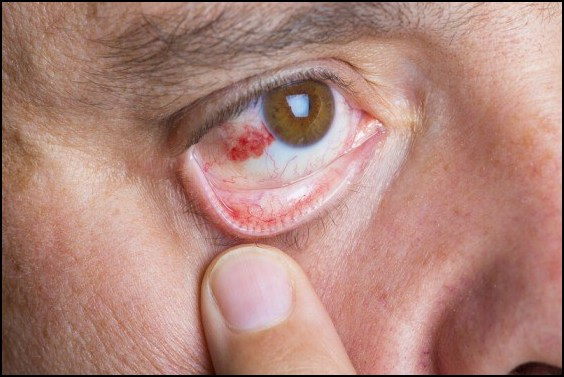Ayurvedic Treatment for Scleritis with Herbal Remedies
ABSTRACT
Scleritis is the inflammation of sclera – a white part in the eye that cushions the rest of the eye parts. It covers most of the eyeball and expands from cornea in the anterior (front) to the optic nerve in the posterior portion (back). Its main function is to maintain the shape of the eyeball and protect it from any kind of injury. The layer covers the sclera is known as conjunctivitis – which on closing or opening the eye helps in the lubrication of the eyeball. So for maintaining the health of the eye it is important to maintain the health of sclera. Here we are going to discuss scleritis – a disease of sclera in modern as well as ayurveda along with its ayurvedic management.

INTRODUCTION
In scleritis the sclera of the eye becomes more red and inflamed. The condition is very painful and considered as an overreaction of the immune system. It occurs in different regions of sclera and pain may vary on the basis of different sites. The 62% cases of scleritis are diffuse, 27% of cases are nodular, 11% are posterior. Further we will discuss in detail. It is a must to do its early management otherwise there will be complications of vision loss. As per ayurveda it is correlated to sirajaal and further we will discuss all about scleritis in detail as per modern and ayurveda.
CAUSES
There are certain kinds of theories that consider T cells as the main cause of scleritis. The T-cells are the part of the immune system and this system consists of a number of parts that are a network of tissues, organs and the circulatory cells that restrict the viruses, bacteria and other infections to grow and cause illness. It is to be believed that T-cells attack the body ‘s scleral cells and lead to scleritis. Although the exact cause of the scleritis is not known but here are some risk factors that can lead to this condition that are mentioned as below:
Some Risk Factors
- Joint swelling
- Lupus erythematosus
- Any eye infection
- IBD
- Sjogren’s syndrome
- Scleroderma
- Granulomatosis
- Trauma
- Fungal or parasitic infection
- Rheumatoid arthritis
TYPES OF SCLERITIS
The classification of scleritis is done on the basis of the site which is affected and mainly there are two types of scleritis that are anterior and posterior. Further we will discuss both these types in brief.
- Anterior Scleritis: It is the most common type of scleritis which is of three types. The first one mostly includes irritation and redness in the whole sclera and is easily manageable. In the second type there is a formation of tender nodules and the last one is most severe and may lead to scleral degeneration.
- Posterior Scleritis: This type is the rarest one and associated with severe pain and tenderness. It can lead to close angle glaucoma and retinal detachment.
SYMPTOMS OF SCLERITIS
Common Symptoms of Scleritis are as Follows
- Pain
- Tenderness
- Redness
- Swelling
- Blurred vision
- Sensitivity towards light
- Tearing of scleral tissue
- Degeneration of sclera
DIAGNOSIS
It is a must to visit an ophthalmologist if you are facing any of the above mentioned symptoms in your eye. In case of ignorance it may lead to degeneration of the sclera and further vision loss. An ophthalmologist may take your proper history and then for clear diagnosis the ophthalmologist may examine your eye under the slit lamp. For evaluating the risk factors certain blood tests are needed to be performed.
AYURVEDIC VIEW
As we read earlier, as per ayurveda scleritis is correlated with sirajaal. Definition: According to acharya sushruta (su. u. 4/8) the formation of hard, huge and red-colored blood vessels all over the sclera of the eye is known as sirajaal (scleritis).
Classification: On the basis of site Sirajaal is classified under Shuklagata Roga (diseases of sclera). On the basis of dosha predominance, Pitta aggravated Vyadhi. Prognosis of this condition is good so it is classified under Sadhya roga (curable diseases).
Treatment of Siraajaal: The treatment of Siraajaal as per Ayurveda can be done in three main steps that are Chedana, Armokta Chikitsa and Abhishyandi Chikitsa.
Chedana Chikitsa: The large and hard blood vessels formed in Sirajaal held with the help of badisha yantra (Hook like tool) and lift up from their site. After lifting blood vessels to be excised with the help of Mandalagra shastra (knife with round edge).
Armokta Chikitsa: After excision the treatment should be done same as that of other Shuklagata rogas i.e. same as that of Arma (Pterygium). So after excision, mild rubbing is to be done with the Kshara (alkali) obtained by burning the Yava (Barley), Pippali (Piper longum), Maricha (Piper nigrum) and shunthi (Zingiber officinale).
Abhishyandi Chikitsa: The next step to treat Sirajaal is as per the line of treatment of Abhishyand (Conjunctivitis). In this line of treatment along with scraping medications dosha shamaka chikitsa is to be done. For dosha shamana Planet Ayurveda provides a list of herbal remedies that we are going to discuss further.
HERBAL REMEDIES BY PLANET AYURVEDA FOR SCLERITIS
For the management purpose of Scleritis (sirajaal) Planet Ayurveda provides a list of 6 Herbal Remedies. All the formulations prepared by Planet Ayurveda under the strict observance of M.D. Ayurveda practitioners. These formulations are free from any kind of additives, fillers, colour, starch and any kind of other synthetic material. Further we will discuss the herbal remedies for scleritis and how these formulations help in the management of Scleritis individually.
- NEEM CAPSULES
- GANDHAK RASAYAN
- AMALAKI RASAYAN
- SEPTRIN TABLETS
- PANCHTIKTAGHRIT GUGGUL
- JASNOOR EYE DROPS
PRODUCT DESCRIPTION
1. NEEM CAPSULES
Neem capsules by Planet Ayurveda consist of standardized extract of herb neem (Azadirachta indica). This formulation is rich in several properties such as tikta (bitter) and kshaya (astringent) taste and sheeta (cold) potency. The herbal remedy purifies the blood, prevents the growth of free radicals, and flush out toxins from the body. It regulates the blood circulation hence is effective in the management of scleritis.
Dosage: 1 capsule twice daily with plain water.
2. GANDHAK RASAYAN
Gandhak rasayan by Planet Ayurveda consists of shuddha gandhak (purified sulfur). It possesses rejuvenating properties and maintains overall health of the body. These tablets possess various properties such as antibacterial, antimicrobial, antiviral and blood purifying. It is very effective in eliminating the infection in the blood thus alleviates the inflammation of the blood vessels in sclera.
Dosage: 2 tablets twice daily with plain water
3. AMALAKI RASAYAN
Amalaki rasayan is a formulation in capsule form prepared by Planet Ayurveda which consists of standardized extract of amalaki (Emblica officinalis). It has potent antioxidant properties that help in preventing any kind of degeneration in the body. As we studied earlier in scleritis if treatment is delayed it may lead to the degeneration of sclera. So for preventing the scleral degeneration we can add amalaki rasayan to the management of scleritis.
Dosage: 1 capsule twice daily with plain water after meals.
3. SEPTRIN TABLETS
Septrin tablets are formulated by Planet Ayurveda by various ingredients such as guggul (Commiphora mukul), haldi (Curcuma longa), tulsi (Ocimum sanctum), sonth (Zngiber officinale). These tablets include immunomodulatory and antioxidant properties that are very beneficial in providing relief from the symptoms of scleritis. As scleritis is a condition associated with the overaction of the immune system thus by boosting the immunity and regulation the functions of the immune system septrin tablets aids in the management of the scleritis.
Dosage: 2 tablets twice daily after meals.
4. PANCHTIKTAGHRIT GUGGUL
As the name suggests this herbal remedy consists of the herbs considered as panchatikta that are neem (Azadirachta indica), giloy (Tinospora cordifolia), vasa (Adhatoda vasica), patol (Vigna radiata) and kantakari (Solanum virginianum) with ghee and guggul (Commiphora mukul). This formulation is prepared by Planet Ayurveda in tablet form with these ingredients under the strict guidance of M.D. Ayurveda doctors. The herbal remedy contains detoxifying and blood purifying properties that are very effective in cleansing the blood and alleviating the condition of scleritis. Guggul present in this formulation assists in reducing the inflammation in the sclera, so overall the remedy is effective in managing scleritis.
Dosage: 2 tablets twice daily with plain water after meals.
5. JASNOOR EYE DROPS
Jasnoor eye drops is a miraculous formulation that is used to manage various eye problems. The ingredients of jasnoor eye drops are neem (Azadirachta indica), tulsi (Ocimuj sanctum), haritaki (Terminalia chebula), bibhitaki (Terminalia billerica), amalaki (Emblica officinalis), shweta chandan (Santalum album), mukta (pearl) and some others. The ingredients of these eye drops are effective in promoting eye health due to its various properties such as chakshushya (improves eye health), shothahara (alleviates inflammation), shoolhara (reduces pain), tridosha shamaka (balancing tridosha), sheeta (cold) and rasayana (rejuvenating). All these properties make herbal eye drops effective in alleviating scleritis by preventing the degeneration of sclera and reducing pain, inflammation and all other associated symptoms of scleritis.
Dosage: Put 3 drops in each eye twice daily.
CONTACT MY ASSISTANT TO PROVIDE YOU THE COSTING / ORDERING AND DELIVERY INFORMATION AT – COSTING.PLANETAYURVEDA@GMAIL.COM OR CALL AT +91-172-5214040 OR CHECK WEBSITE – WWW.PLANETAYURVEDA.COM
CONCLUSION
Scleritis is the inflammation of sclera – a white part in the eye that cushions the rest of the eye parts. In scleritis the sclera of the eye becomes more red and inflamed. The condition is very painful and considered as an overreaction of the immune system. As per ayurveda it is correlated to the condition of sirajala in which there is the formation of hard, huge and red-colored blood vessels all over the sclera of the eye. The condition is associated with pain and tenderness in the eye and if not treated may lead to a scleral degeneration and even a vision loss. So if you are suffering from the same condition you can start with an ayurvedic treatment by Planet Ayurveda. They are provided with 6 herbal remedies that help in alleviating the symptoms and preventing the degeneration of the sclera too. All these herbal remedies are devoid of any kind of additives and preservatives like things so feel free to add these herbal remedies as your management choice and get rid of your condition safely. For any queries you can share your concern on herbalremedies123@yahoo.com.


